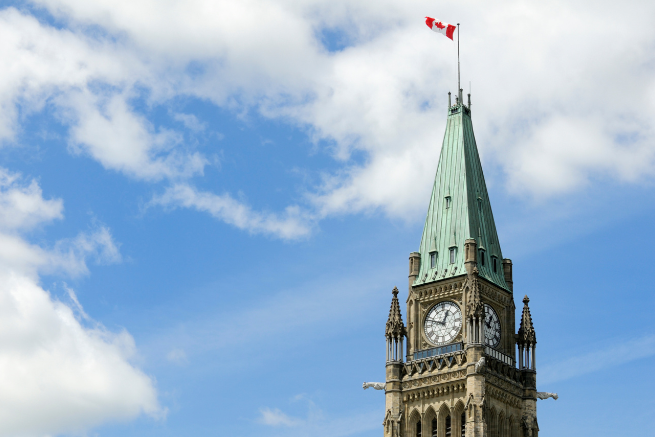
As Canada approaches the 2025 federal election, the RAIC is spearheading critical conversations with political candidates and citizens about architecture's vital role in creating communities that are sustainable, equitable, and resilient.
With the federal government standing as Canada's largest property owner, it has both the responsibility and opportunity to establish exemplary standards in design excellence and environmental stewardship. High-quality buildings and infrastructure represent more than physical assets—they are investments in our national prosperity, health, and quality of life.
The RAIC has posed the following questions to parties contesting the election. Their responses will be published online and distributed to RAIC membership, helping to inform the architectural community and the public about each party's vision for Canada's built environment.
1. Building Climate Resilience
How will your party ensure that Canada’s cities and communities are designed to withstand the increasing risks posed by climate change, including extreme weather, rising temperatures, and infrastructure vulnerabilities? What role do you see for architects in implementing climate adaptation strategies?
2. Sustainable Housing and Affordability
Canada is in the midst of an urgent housing crisis, with affordability and sustainability at the forefront of public concern. How will your party support the rapid scaling of housing supply while ensuring new developments meet high environmental and livability standards? What specific policies will be introduced to incentivize sustainable and affordable housing solutions?
3. Low-Carbon Infrastructure, Regenerative Development and Design, and Energy Transition
Public infrastructure plays a significant role in shaping Canada’s emissions profile and energy efficiency. How will your party prioritize investment in green building design, low carbon construction, regenerative development and design, and climate-conscious retrofits of existing infrastructure?
4. Mobility, Urban Density, and Transportation
Sustainable cities rely on smart urban design that integrates transit-oriented development, walkable neighborhoods, and efficient mobility systems. What measures will your party take to support active transportation, improve public transit, and reduce dependence on carbon-intensive infrastructure while enhancing affordability and accessibility?
5. Disaster Preparedness and Risk Reduction
With climate-related disasters such as floods, wildfires, and heat waves becoming more frequent, how will your party strengthen federal policies on disaster resilience in the built environment? What steps will be taken to ensure that new and existing developments incorporate resilient design principles?
6. Equity in the Built Environment
Sustainable development must also be inclusive. How will your party ensure that federal policies on housing, infrastructure, and urban development address the needs of Indigenous communities, low-income Canadians, people with disabilities and others from historically underrepresented groups? How will your party collaborate with the architectural profession to foster inclusive, accessible, and culturally responsive design solutions?
7. Procurement Reform and Quality-Based Selection
Public procurement policies have a significant impact on the quality and sustainability of Canada’s built environment. Will your party commit to implementing Quality-Based Selection (QBS) as the standard for public-sector procurement of architectural and engineering services, ensuring that design excellence, sustainability, and long-term value take precedence over lowest- cost bidding? How will your party support reforms that enhance fairness, transparency, and innovation in government procurement processes?
8. Fair Compensation for Architects and Design Professionals
Ensuring fair compensation for architectural services is crucial to maintaining high design standards and fostering a thriving, innovative profession. How will your party address issues of underfunded public projects and inadequate compensation structures for architects and other design professionals working on federally funded initiatives? What measures will be taken to promote fair remuneration and recognition of architectural expertise in shaping Canada’s built environment?
The federal election takes place on April 28, 2025, and we encourage all RAIC members to make their voices heard and make an informed decision at the polls.
Here’s how to get involved:
1. Contact your candidates
Contact the candidates in your riding. Send them the RAIC questions and ask them for their views. Tell them what issues matter to you and why. Tell them who you are: e.g. a constituent, an architect, a member of the RAIC, and a small business owner. Tell them you’re willing to be a go-to person if they have questions about the built environment. Use this opportunity to build personal relationships with the candidates running for office. Don’t forget to cc the RAIC communications@raic.org
Here is a copy of the letter the RAIC sent the political party leaders. You may adapt the copy used in this letter to formulate your own letter.
2. Spread the word on social media
Share the RAIC brief on Facebook, Twitter, LinkedIn, and Instagram. Remember to use the hashtags #DesigningCanadasFuture #RAICvotes and #RAICVotes2025.
3. Meet your candidates
Set up a meeting with your candidates, either through your firm, or a group of RAIC members. Discuss the issues facing the built environment today and ways to promote better results in design and construction. Offer yourself as an expert to consult on these issues. Candidates want to know how a specific issue will affect their riding so use local or personal experiences to emphasize your points.
Meet personally with a candidate you have donated to or worked for or with whom you have a relationship. Find your MP here.
4. Attend a town hall meeting
Attend a town hall meeting and ask questions. Identify yourself as a constituent and an architect.
5. Tell the media
Email the RAIC brief to local journalists covering the election. Offer to be available for an interview or write an op-ed article.
6. Election Resources
Are you registered to vote? Check HERE
Find your riding and candidates HERE
Accessible Voting
Read the party platforms:
Liberal Party
New Democratic Party
Green Party
Conservative Party
Bloc Quebecois



